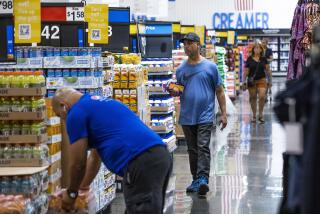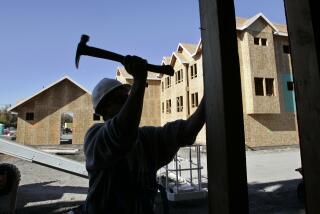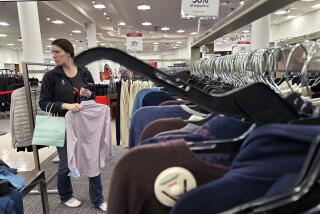Economy Growing at Solid Pace : Indicators: Construction spending rose for third straight month. Gains in wholesale prices fan inflation worries.
The national economy is growing at a solid but more moderate pace, according to a pair of government reports released Friday, although an increase in wholesale prices fueled fears that inflation may become a problem later this year.
The government said its chief forecasting gauge of economic activity was unchanged again in May, while construction spending rose 0.9%, the third straight monthly increase. Meanwhile, a June survey by the National Assn. of Purchasing Management showed more factories paying higher prices for raw materials than at any time in nearly six years.
However, despite the inflation worries, several economists said they do not expect the Federal Reserve Board to raise short-term interest rates when its Federal Open Market Committee meets Tuesday.
Gary Ciminero, chief economist for Fleet Financial Group in Providence, R.I., said no further increases in interest rates are necessary unless the Fed is presented with more bad news about inflation.
“Something else would have to go wrong,” he said, adding that “with the four rate increases (this year), the Fed has now achieved monetary neutrality.”
The purchasing managers reported that more of the country’s 300 largest industrial companies paid higher prices in June than they had since August, 1988. The price index, which measures how many companies are paying higher prices, rose to 73.5% in June from 71.5% in May.
In addition, the purchasing managers index showed overall manufacturing growth strong in June for the 10th straight month, though slightly weaker than in May.
The Commerce Department’s index of leading economic indicators suggested that manufacturing growth will be shared by other sectors of the economy.
The government’s chief measure of future economic activity remained at 101.2 in May--unchanged for the second straight month but still at the highest level since the government began keeping the index in 1948.
Seven of 11 components of the index of leading economic indicators rose in May, including the length of time it took producers to fill orders, a sign of increased business. Also on the uptick were prices for raw materials, a growing inventory of durable goods, a higher index of consumer expectations, more orders for consumer goods and more business orders for plants and equipment.
Offsetting those gains were more weekly initial claims for unemployment insurance, a shorter average workweek, a smaller money supply and fewer building permits issued. The index had risen for eight straight months before topping off in March.
The construction spending report shows increases for all major sectors, including homes, businesses and school buildings. The Commerce Department said outlays for all categories totaled $504.2 billion, up from a revised $499.5 billion in April, when spending increased 0.7%.
Taken together, the “reports show the economy is perhaps moving to a more moderate--but more sustainable--growth track,” said Lynn Reaser, chief economist at First Interstate Bancorp in Los Angeles.
Given the mixed signals in the latest statistics, Fed officials are likely to wait until later in the third quarter before contemplating a fifth increase in short-term rates, said Joe Carson, chief economist at Dean Witter in New York.
The Fed may also be wary about raising rates to halt the dollar’s slide against the Japanese yen. The dollar closed at 98.55 yen in New York on Friday, up from a postwar low of 98.50 on Thursday.
Several economists said linking monetary policy to exchange rates would be a dangerous gamble, because the dollar could continue to fall. Also, they said, leaders of the world’s seven major industrial countries may devise their own strategy to stabilize the dollar when they meet in Naples, Italy, next week.
Index of Leading Indicators
Seasonally adjusted index; 1987 = 100
May, 1994: 101.2
Source: Commerce Department
More to Read
Inside the business of entertainment
The Wide Shot brings you news, analysis and insights on everything from streaming wars to production — and what it all means for the future.
You may occasionally receive promotional content from the Los Angeles Times.











